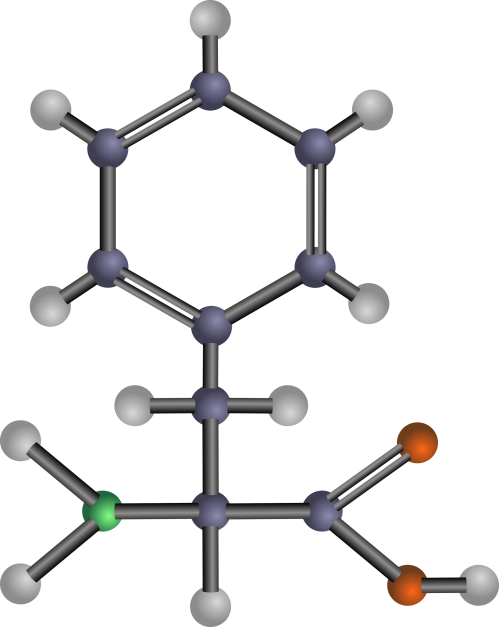Creative Biolabs is a leading service provider that focuses on polyclonal, monoclonal, and recombinant antibody development for research, diagnosis, and potential therapeutics. Based on our extensive experience and state-of-the-art platforms, Creative Biolabs now offers a series of biomarker-specific IVD (in vitro diagnostic) antibody development services to clients globally. Especially, we introduce our IVD antibody development services for phenylalanine marker.
Phenylalanine is a crucial amino acid which can be regarded as a phenyl group instead of a terminal hydrogen of alanine or a benzyl group in place of the methyl group of alanine. It is a building block for proteins in the body and have to be got from food. There are 3 forms of phenylalanine: L-phenylalanine (the inartificial form discovered in proteins), D-phenylalanine (a mirror image of L-phenylalanine that is produced in a lab), DL-phenylalanine (a combination of the 2 forms). Besides, phenylalanine is the precursor for tyrosine and dopamine-related neurotransmitters. Study in the pathophysiology of ischemia/reperfusion or redox signaling is impeded by the absence of simple approach to detect short-lived oxygen radicals. In the existence of hydroxyl radical, D-phenylalanine (D-Phe) forms para-, meta- and ortho- tyrosine. Various types of research have already indicated that D-Phe enables to precisely measure hydroxyl radical production in chemical, enzymatic and cellular systems by simple HPLC methodology.
 Figure 1. The model structure of hydroxylation. Phenylalanine is a precursor for norepinephrine, epinephrine and tyrosine. It plays an important role in the determination of hydroxyl radical production in chemical, enzymatic and cellular systems.
Figure 1. The model structure of hydroxylation. Phenylalanine is a precursor for norepinephrine, epinephrine and tyrosine. It plays an important role in the determination of hydroxyl radical production in chemical, enzymatic and cellular systems.
Phenylalanine Marker of Cardiovascular Disease
Cardiovascular disease (CVD) is the major cause of morbidity and mortality around the world. Cardiovascular risk evaluation depends on established risk factors, such as hypertension, dyslipidemia, and diabetes mellitus. Nevertheless, according to current risk algorithms, the first CVD events usually emanate from people classified as being at low or intermediate risk. Researchers have found that D-Phe is a subtle approach for identification of hydroxyl radical formation in the heart because it is not a substrate for endogenous enzymes. Besides, a recent research used NMR metabolomics profiling of 13,441 peoples with long-term follow-up has demonstrated that phenylalanine is a new biomarker of CVD event risk. In addition, phenylalanine is more highly correlated with CVD before 60 years of age, and it is a more potential marker for the early determination of cardiovascular risk.
Phenylalanine Marker of Liver Function
The liver is a crucial organ in the body, and it has a variety of functions, such as detoxification of various metabolites and the formation of biochemicals required for digestion. Human obesity is connected with raised serum phenylalanine concentration, which is possibly induced by liver dysfunction associated with liver steatosis. It was demonstrated that bariatric surgery caused weight loss had favorable effects on serum phenylalanine. A positive connection between serum phenylalanine and serum ALT concentrations displays that the deterioration of liver function is contributing to a reduction in phenylalanine metabolism and thereby to the raise of serum phenylalanine concentration. Thus, serum phenylalanine concentration was a promising marker of liver function in obese patients.
IVD Antibody Development Services Targeting Phenylalanine Marker
IVD antibodies are extensively used in immunodiagnostic tools for disease screening and therapeutic monitoring. Through our role as a leading antibody service provider, Creative Biolabs is well-positioned to develop high-quality anti-phenylalanine antibodies. Besides antibody generation, Creative Biolabs also offers diagnostic immunoassay development services, including feasibility analysis, assay design, assay protocol establishment, assay optimization, and kit production. If you are interested in our IVD antibody discovery services, please contact us for more details.
References
- Swierczynski, J. (2009). “Serum phenylalanine concentration as a marker of liver function in obese patients before and after bariatric surgery.” Obesity surgery 19(7), 883-889.
- Würtz, P. (2015). “Metabolite profiling and cardiovascular event risk: a prospective study of three population-based cohorts.” Circulation CIRCULATIONAHA-114.
- Biondi, R. (2006). “Hydroxylation of D-phenylalanine as a novel approach to detect hydroxyl radicals: application to cardiac pathophysiology.” Cardiovascular research 71(2), 322-330.
For Research Use Only.

